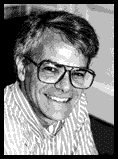
Gottesman
| T H E N I H C A T A L Y S T | J U L Y - A U G U S T 1 9 9 8 |
| F R O M T H E D E P U T Y D I R E C T O R F O R I N T R A M U R A L R E S E A R C H | |
| FOSTERING COLLABORATION AND TEAMWORK AT NIH | |
 |
|
Gottesman |
NIH has traditionally been known as an institution that is able to assemble multidisciplinary teams of researchers to solve difficult biomedical research problems–an excellent recent example is the diverse multi-institute group that identified MEN-1, the multiple endocrine neoplasia gene. In the years ahead, collaborative, interactive groups of scientists will become increasingly critical in areas such as vaccine development, imaging research, huge sequencing and mapping projects, and combinatorial analysis and screening of thousands of potential new drugs. At NIH, for example, our efforts to develop vaccines against AIDS and other diseases inherently require the cooperative efforts of virologists, immunologists, molecular biologists, molecular modelers, chemists, pharmacologists, and clinicians. These scientists, in turn, need the back-up of talented support staff.
But almost like entropy, tugging away at efforts to assemble ordered, cooperative teams, are mitigating forces deeply ingrained in the culture of science: esteem of individual achievement and the pride and creativity that flow from independent scientific efforts. The system of investigator-initiated independent research has historically led to astounding levels of scientific achievement and motivated scientists to the highest levels of performance. The Intramural Research Program has encouraged independent scientific effort with the creation of a tenure track, a stringent tenuring process, and clearer demarcation of the privileges and responsibilities of the tenured independent investigator.
The competing forces of individual achievement and team effort come to their most agonizing conflict for the tenure-track scientist. Is it ever advisable to collaborate with a powerful and successful senior scientist? What about joining a creative, productive, star-studded team that is on its way to a major scientific breakthrough?
The tenure process at NIH now entails the review of an individual scientist’s accomplishments by an NIH-wide panel–the Central Tenure Committee. This group of senior NIH scientists looks at recommendations from the leadership of the candidate’s institute, evaluations from institute promotion and tenure committees, Board of Scientific Counselors’ reviews of the scientist’s work, letters from outside scientists, publications, mentoring skills, and future plans.
For the scientists who make it through the tenure track to come before the Central Tenure Committee, the most difficult question–and a leading cause for denial of tenure at NIH–is the question of intellectual independence.
|
For the tenure-track scientist who is inclined by personality or circumstances to collaborate with a more senior investigator or to join a larger team to solve an important biological problem, I offer the following advice: Work cooperatively, but carve a distinctive niche within the project that is clearly defined as your territory.
Make sure that you are developing an area of expertise that is distinctly your own and is recognized by your scientific colleagues at NIH and elsewhere. It is acceptable to collaborate with your supervisor, but not on every paper, and not always as a junior author. Present your work at major meetings. Make yourself visible and known personally to the outside experts in your field who will someday be asked to comment on your work.
For my senior colleagues who are mentoring brilliant early-career scientists, I offer this advice: Do everything you can to be sure that you encourage independence of thought and action so that your junior colleague can occupy a unique niche in any joint projects. Give your junior colleagues every opportunity to present their work and be sure to credit them appropriately in every presentation you give.
In the years ahead, NIH and other academic institutions will increasingly need to build new teams and larger collaborative groups. This endeavor will not be easy. We will need to work with our Boards of Scientific Counselors so that they appreciate that intellectual independence can flourish in a collaboration among partners of unequal position. We will have to find ways to cultivate a new breed of research leader who can assemble and motivate dynamic, productive groups. We will have to find new ways to encourage the formation of teams, to keep them integrated and functioning efficiently, and then to honor their success. I welcome your advice on how we can best accomplish these goals.
-Michael Gottesman
Deputy Director for Intramural Research